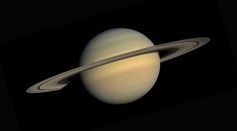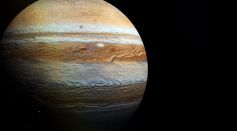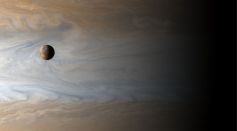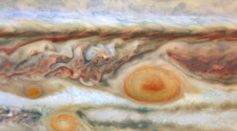Tags: Gas Giant

Halloween Surprise: NASA Juno Probe Takes Spooky Shot of Ghoulish Face Over Jupiter Surface During Its 54th Close Flyby

Saturn's Hidden Megastorms That Happened Centuries Ago Leave Long-Lasting Atmospheric Scars
Saturn Experiences Hundred-Year-Long Mega Storms With Impacts That Challenge Our Understanding of the Gas Giant

James Webb Space Telescope Captures Its First Image of Saturn, Reveals the Glowing Rings of the Gas Giant

Saturn's Rings Are No Older Than 400 Million Years Old, Younger Than the Gas Giant Planet Itself

Unexpected Patterns of Temperatures in Jupiter Found in a 40-Year Study From Generations of NASA Missions

Surprising Discovery on Jupiter: Scientists Find Remnants of Baby Planets Swallowed by the Gas Giant

Planet Jupiter a Hoax? Expert Debunks Gas Giant Deniers

Gas Giant Planets Like Jupiter, Saturn Orbiting V1298 Tau Star Could Reach Final Size At Very Early Stages of Evolution

Giant Planets Telescopic View: Chemist Offers Planet-Gazing Adventure Featuring Saturn, Uranus and Neptune in Athens

Hubble Space Telescope Releases Mind-Blowing Images Captured from Outer Solar System's Gas Giants Showing Unique Planetary Activities

Short Gamma-Ray Bursts Originate From a Dying Star; Super Short GRB Recorded From Andromeda
“Cotton-Candy” Exoplanet WASP-107b Apparently Has Less Core Mass Than Previously Thought
Largest Known Rocky Planet 40 Times Larger Than Earth Found Orbiting a Sun-Like Star 730 Light Years Away

Juno Spacecraft Discovers the Hexagon-Shaped Storm on Jupiter's South Pole
Most Popular

Largest Known Volcanic Aquifer Discovered Beneath Oregon's Cascades

New 'Supergiant' Sea Bug Found in South China Sea, Named After Darth Vader

Mediterranean Sea Was Refilled by a Catastrophic Flood Millions of Years Ago

Mysterious Cosmic Waves That Sound Like Birds Detected in Unexpected Space Region





